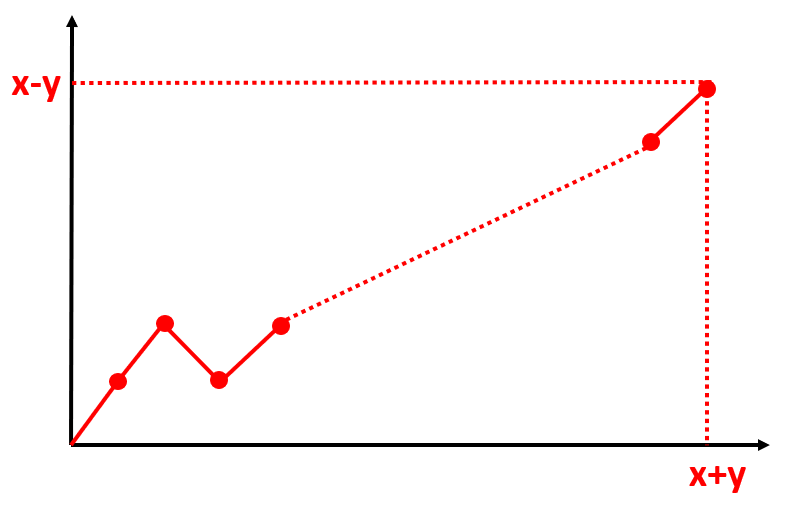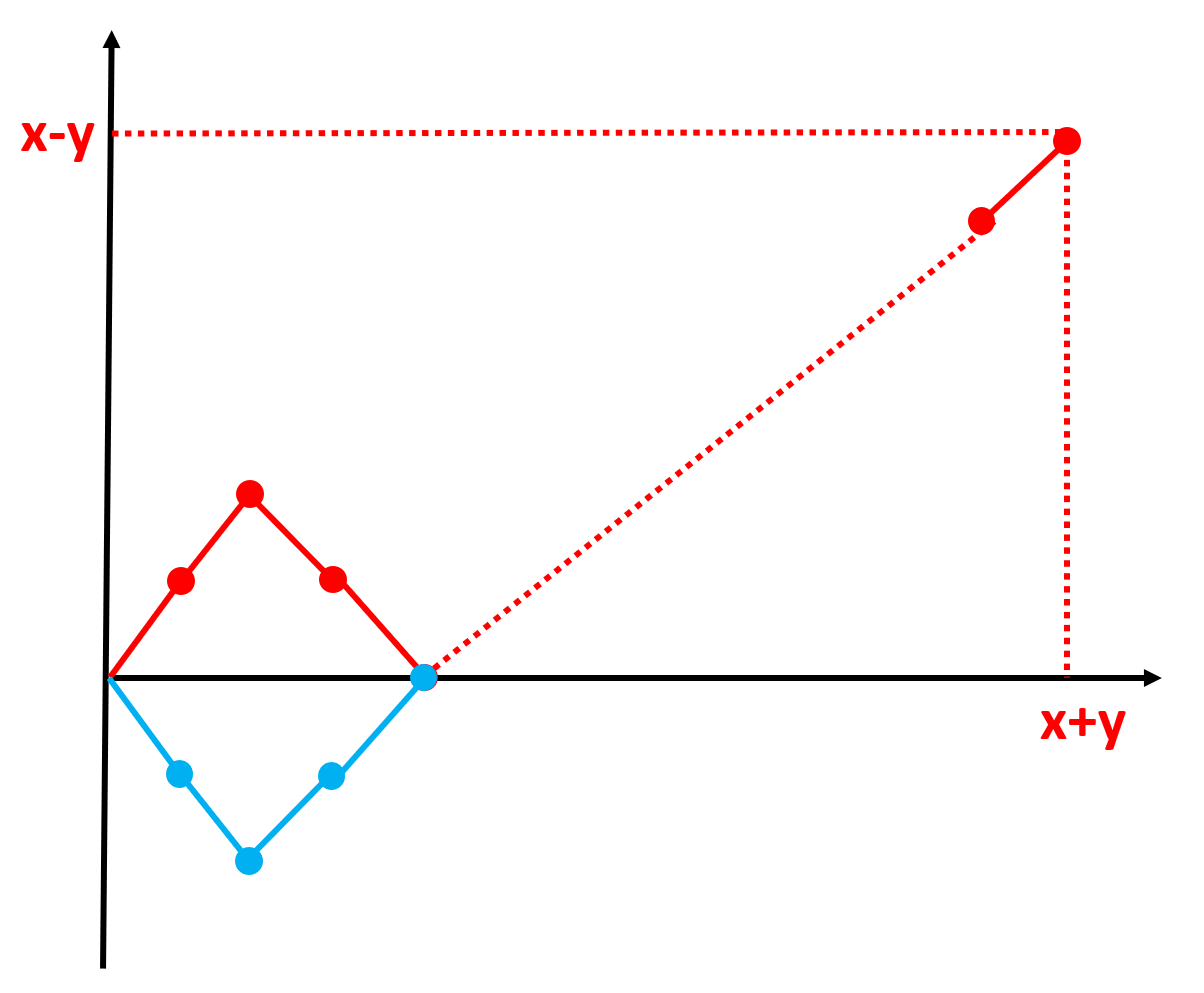[COMP2121] Bertrand's Ballot Problem and Balanced Bracket Sequence
Description
Suppose there are $x$ votes for $A$ and $y$ notes for $B$, and $x>y$. How many sequences are there of revealing the votes such that the number of votes for $A$ is always strictly bigger than that for $B$?
Solution (by reflection)
First, we draw the process of revealing the votes using line charts (the horizontal axis represents the number of votes revealed, and the vertical axis represents $x_{cur}-y_{cur}$):

Define the grand set $\Omega$ as the set of sequences that starts from $0$ and ends at $x-y$. A valid sequence drawn in such a way should never touch the horizontal axis.
Note that the first vote must be a "+1". Let $A$ denote the set of sequences whose first element is "+1" and $B$ denote the set of sequences whose first element is "+1" but not valid (touches 0 at some point). Then the answer would be
$$|A| - |B|$$
It is easy to see that
$$|A| = \frac{(x+y-1)!}{(x-1)!y!}$$
Now use the technique of bijection to compute $|B|$, i.e. find an easily-computable set $C$ so that sequences in $B$ and $C$ have a one-to-one relation.
We attempt to find $C$ in such a way: for every sequence in $B$, reflect the prefix before the line first touches 0 with respect to the horizontal axis to get a sequence in $C$:

By observing, we try to define $C$ to be the set of sequences whose first element is "-1" (and ends at $x-y$). Then, according to the mapping, different sequences in $B$ will result in different sequences in $C$, so the mapping is injective. Also, for every sequence in $C$, a sequence in $B$ is obtained by reflecting $C$'s prefix before first touching 0 (such prefix always exists because it goes from $-1$ to $x-y$), so the mapping is bijective. Therefore, we successfully find the $C$ we want.
Now compute $|C|$. Suppose in the next $x+y-1$ steps, there are $a$ "+1"s and $b$ "-1"s, then:
$$\left\{\begin{matrix}a+b=x+y-1 \\-1+a-b=x-y\end{matrix}\right. \Rightarrow \left\{\begin{matrix}a=x \\b=y-1\end{matrix}\right.$$
Thus,
$$|C|=\frac{(x+y-1)!}{x!(y-1)!}$$
Alternatively, $C$ is the complement of $A$, thus:
$$|C|=|\Omega|-|A|=\frac{(x+y)!}{x!y!}-\frac{(x+y-1)!}{(x-1)!y!}=\frac{(x+y-1)!}{x!(y-1)!}$$
Finally, we can compute the answer:
$$|A|-|B|=|A|-|C|=\frac{(x-y)(x+y-1)!}{x!y!}$$
Moreover, the corresponding probability is:
$$p=\frac{\frac{(x-y)(x+y-1)!}{x!y!}}{\frac{(x+y)!}{x!y!}}=\frac{x-y}{x+y}$$
联想:合法括号串(Catalan数)
这两个问题十分相似,区别在于括号串问题中,左括号和右括号的差值可以为0。其实,长度为$2n$的合法括号串数量等于第$n$个 Catalan 数$C_n$,其通项公式也可以用十分相似的方法推导出来。
$A$代表$n$个左括号和$n$个右括号的全部排列,$B$代表其中不合法的括号序列,则答案为:
$$C_n=|A|-|B|$$
不难写出:
$$|A|=\frac{(2n)!}{n!n!}$$
现在考虑计算$|B|$。沿用上述表示,用以下方法将$B$中的序列映射至$C$:将序列$B$截至第一次差为$-1$的前缀进行翻转,即左括号变成右括号,右括号变成左括号,如 (())) 变成 ))(((。假设这样的前缀为$[1,k]$,则$k$必为奇数(若为偶数,则$[1,k-1]$亦满足条件),因此原前缀有$\frac{k-1}{2}$个左括号和$\frac{k+1}{2}$个右括号,因此翻转后,总序列共有$n-\frac{k-1}{2}+\frac{k+1}{2}=n+1$个左括号,$n-\frac{k+1}{2}+\frac{k-1}{2}=n-1$个右括号。那么,$C$即为由$n+1$个左括号和$n-1$个右括号组成的括号串:
$$|C|=\frac{(2n)!}{(n+1)!(n-1)!}$$
考虑是否为单满射。显然满足单射。对于$C$中的每个序列,一定存在一个位置,左括号的数量第一次大于右括号,对截至此位置的前缀进行反转,总可以得到一个不合法的括号串,因此满足满射。因此,$|B|=|C|$。
最后,可以推出:
$$C_n=|A|-|B|=\frac{(2n)!}{n!n!}-\frac{(2n)!}{(n+1)!(n-1)!}=\frac{(2n)!}{n!(n+1)!}$$



 浙公网安备 33010602011771号
浙公网安备 33010602011771号